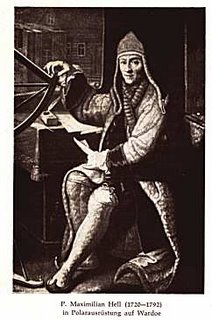54. A Jesuit Named Hell? Who the H - - - is He?
 Maximilian Hell, S.J. died 200 years ago in 1792, after falling victim to the defamation of Jesuits during the Suppression of the Society. Accused of altering his data during the 1769 transit of Venus, he was not exonerateed until a century later when the renowned American astronomer Simon Newcomb found Hell's readings to be correct, his scholarship above suspicion and his accusers guilty of slander. The damage done his reputation, however, survived him because of historians who failed to report his rehabilitation.
Maximilian Hell, S.J. died 200 years ago in 1792, after falling victim to the defamation of Jesuits during the Suppression of the Society. Accused of altering his data during the 1769 transit of Venus, he was not exonerateed until a century later when the renowned American astronomer Simon Newcomb found Hell's readings to be correct, his scholarship above suspicion and his accusers guilty of slander. The damage done his reputation, however, survived him because of historians who failed to report his rehabilitation.Because of his personal qualities as well as his scientific adventures Hell was held in high esteem by all who knew him. He was elected to the most prestigious scientific academies of Europe. The rulers of both England and Denmark offered him large honorary pensions which he modestly declined. At the urging of fellow scientists he attempted to form an imperial academy of science, but was thwarted by political enemies of the Jesuits. He did succeed in publishing a very timely and indispensable journal concerning the latest scientific discoveries. A lunar crater is named after Hell and a 1970 Czechoslovakian stamp honors him dressed as a Laplander recalling his famous scientific expedition.
Maximilian Hell was born into a family of engineers in 1720 in the city of Selmecz (Schemnitz), Hungary. His father was the chief engineer of the local mines and his brother invented an ingenious machine to pump water out of the mine shafts. After joining the Jesuits Maximilian taught mathematics, astronomy, physics and technology and attracted large numbers to his celebrated lectures. He also was a prodigious writer having no less than 35 entries in Sommervogel's Bibliography and requiring 20 pages of narration. Both his teaching and writings promoted a popular understanding and enthusiasm for astronomy, spreading Hell's reputation throughout Europe.
Among his adventures were experiments in magnetism applied to medicine. This was unchartered ground. By assuming very unconventional premises he started something quite remarkable. Using lodestone he devised an arrangement of magnetic plates for the lessening of pain from diseases, including attacks of rheumatism from which he himself suffered. He met with considerable success in relieving the pain. His magnetic medicine attracted the attention of a young man named Franz Mesmer, recently graduated from the Jesuit University of Dillingen in Bavaria. Mesmer disregarded the magnets and developed a different, but even more peculiar theory of healing based on circulating cosmic fluids in the body. The hypothesis of both men were found to be groundless but eventually investigators of these phenomena made mesmerism, or hypnotism, an accepted medical practice.
The story of Hell's detractors can be found in the Dictionary of Scientific Biography, in ISIS and in the modern histories of astronomy. Just before the Suppression, Jesuits directed 30 of the world's 130 major astronomical observatories. Maximilian Hell was so successful in setting up smaller observatories that in 1755 Maria Theresa of Austria and Hungary named him her court astronomer and commissioned him to organize a great central observatory in Vienna. He did so and remained its director for a quarter century. For 37 years he published his unique periodical Ephemerides Astronomicae containing scientific papers and observations which was widely used by the imperial navy, for purposes of the merchant fleet, geodetic surveys and the exact mapping of the empire.
from The Adventures of Jesuit Scientists. Click link for the complete story.



0 Comments:
Post a Comment
<< Home